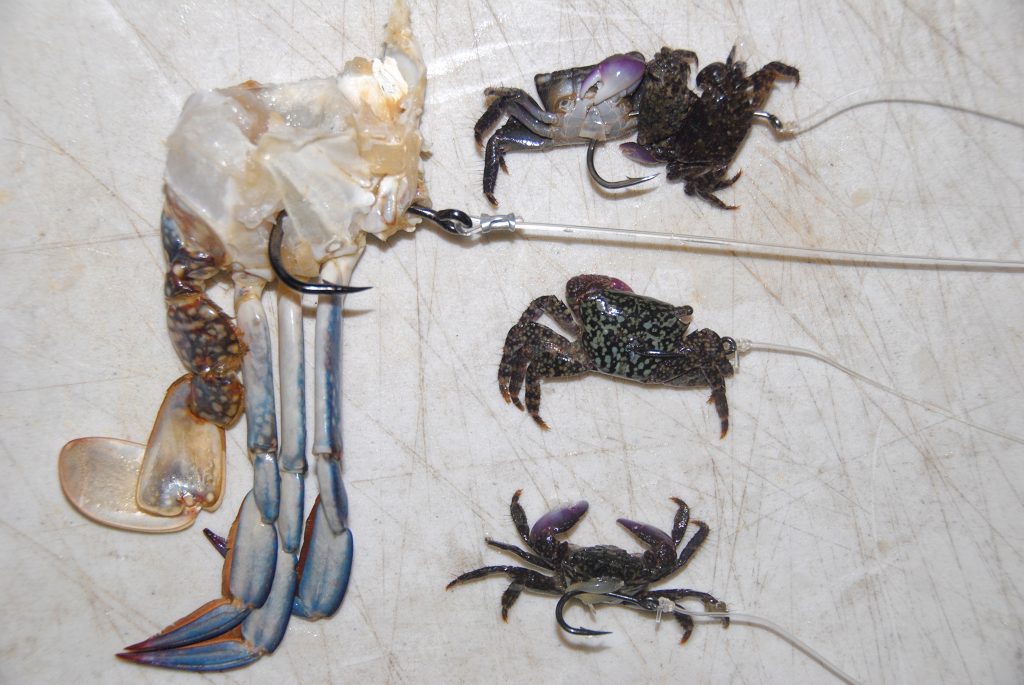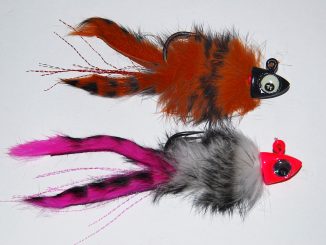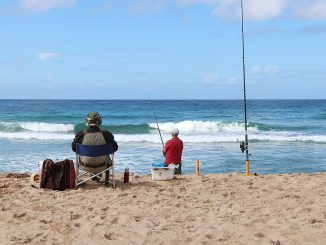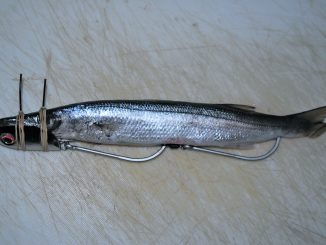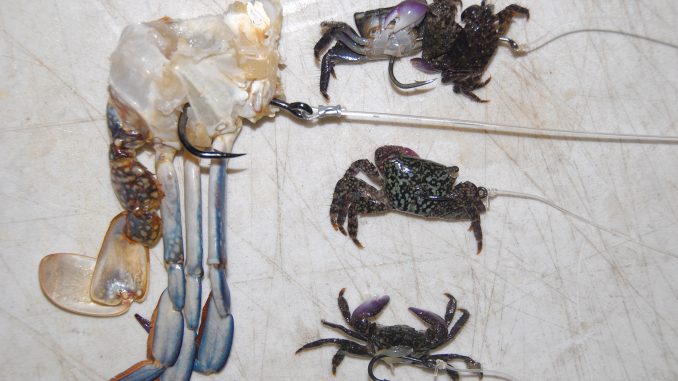
by Gordon Macdonald •
With cooling conditions over the past month and colder conditions predicted for the next few lunar cycles, bay anglers will have their sights set on securing succulent snapper, mouth-watering mulloway or one of the numerous other tasty species that can be encountered within Moreton Bay this month. Other aquatic offerings at this time can include tuskfish, sweetlip, cod, bream, snapper, cobia, flathead and numerous others.
Following on from last month’s article where we looked at five popular bait styles using whole fish and fillets, this issue we will explore some other popular baits available to anglers, plus ways to present these baits that will heighten your chances of getting a bite and hooking up.
6. PRAWNS
One of the more popular baits available to anglers is the humble prawn. We love consuming this tasty crustacean and so do most species of fish. A broad array of bay species will eat prawns and I have readily found them in the stomach contents of tuna and mackerel as well as demersals such as snapper, mulloway, bream, flathead and many others.
Although the humble servo frozen prawn may still entice scavengers such as bream, quality fresh prawns will definitely produce a much better quality fish. For those with a cast net and a good idea of where to find banana and greasy prawns, securing some prime bait will not require too much effort. For others, purchasing quality fresh prawns is the only option. Some bait shops will source these fresh offerings straight from the trawlers, mainly for weekend trade.
Supermarkets and seafood retailers will also have fresh prawns available, but ensure you are only buying locally sourced prawns as using green (uncooked) imported prawns for bait is now illegal since the outbreak of whitespot disease.
Presenting prawns well will greatly increase your chances of connecting with some quality fish. Fishing prawns on a jighead offers a great presentation when drifting, especially around areas such as the artificial reefs, rubble grounds and Coffee Rock.
The prawn is pinned on the hook with the lead head under the prawn’s head and the hook pinned through the second or third segment back from the head. This will allow the tail to waft up and down with the current or rocking of your craft. The head is held onto the lead head using a rubber band or a clear hair band. This bait is generally dropped to the bottom, wound up a metre or so and then allowed to drift along with the rod either hand held or fished out of a rod holder. This bait can also be cast out and hopped back as you would do with a soft plastic or vibe.
When fishing from an anchored position, prawn baits are generally fished a little different. There is a lot of debate as to whether you should have the hook in the head or the tail and I suppose for smaller species (such as bream) the hook in the tail could be more effective. However, when targeting larger specimens, such as mulloway, snapper and the like, this is not as important.
I prefer to have the hook penetrating the first or second joint behind the head with the point exiting under the head. The leader is then half-hitched around the end of the tail so that a bait can be cast and fished in reasonable current without falling off the hook. Obviously the fresher the prawns the tougher they will be. A 3/0-5/0 octopus or baitholder pattern hook is ideal for pinning prawns in this manner.
For species such as sweetlip, bream, smaller snapper and the like, a chunk of prawn tail offers a great bait. This is commonly fished on a short shanked hook (such as an octopus pattern) that can be well hidden inside the chunk with just the point exposed. One decent sized banana prawn can produce several quality baits, with the head often discarded or used for berley.
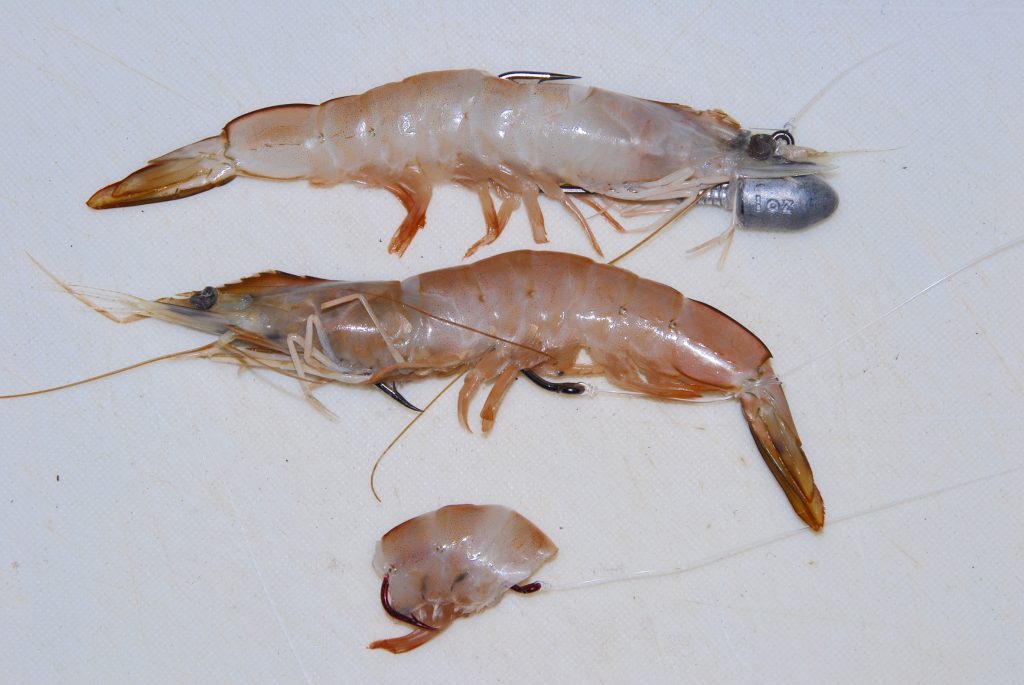
7. SQUID AND CUTTLEFISH
Both of these cephalopods offer anglers a great source of bait. Squid are common offerings anywhere that sells bait, as well as from quality seafood outlets. Fresh is always best, but frozen is also very good. Cuttlefish are a lot harder to source and will probably only be found at some seafood outlets. Squid and cuttlefish can be caught in Moreton Bay and many anglers will go to the effort of securing these with the intention of later using them for bait targeting snapper, mulloway, sweetlip or other species.
Small, whole squid (such as bottle squid) can be presented on a two or three hook snelled rig. This offers great presentation and hooking potential. The size of the snelled rig and the hooks will depend on the squid that you have. Ideally you will want the bottom hook of the rig in the head of the squid and the top hook in the hood (pointed end). A third hook (if desired) will be embedded through the tube between these two.
A head from a larger squid can be fished with a single octopus pattern hook through the middle. Some like to remove the two candles (long tentacles) to prevent them tangling around the main leader, but I leave them on to give the pickers something to chew on while that big wary, knobby gets up the courage to inspect and engulf the bait.
A long strip of squid from a larger specimen can also be fished on a snelled hook rig. I like to cut a long, triangular shaped piece and then fold it over with the inside of the tube facing outwards. Then I pierce the hooks through both thicknesses of the squid to offer a long chunky bait. Additionally, this thicker bait is less likely to roll up into a ball with the hooks fouling.
A smaller strip of squid can be fished on a single hook, with a 2/0-4/0 baitholder pattern being the ideal choice. This bait is ideal for the smaller snapper, sweetlip and other species. Putting the hook all the way through the bait until the hook eye passes through the flesh entirely and then pinning it back through two more times will prevent the bait bunching up on the hook. Small strips of squid threaded onto a no. 4 or no. 6 long shank hook is an ideal offering for big winter whiting. A strip bait has good movement in the water, is easy for the fish to mouth and is also a relatively tough offering.
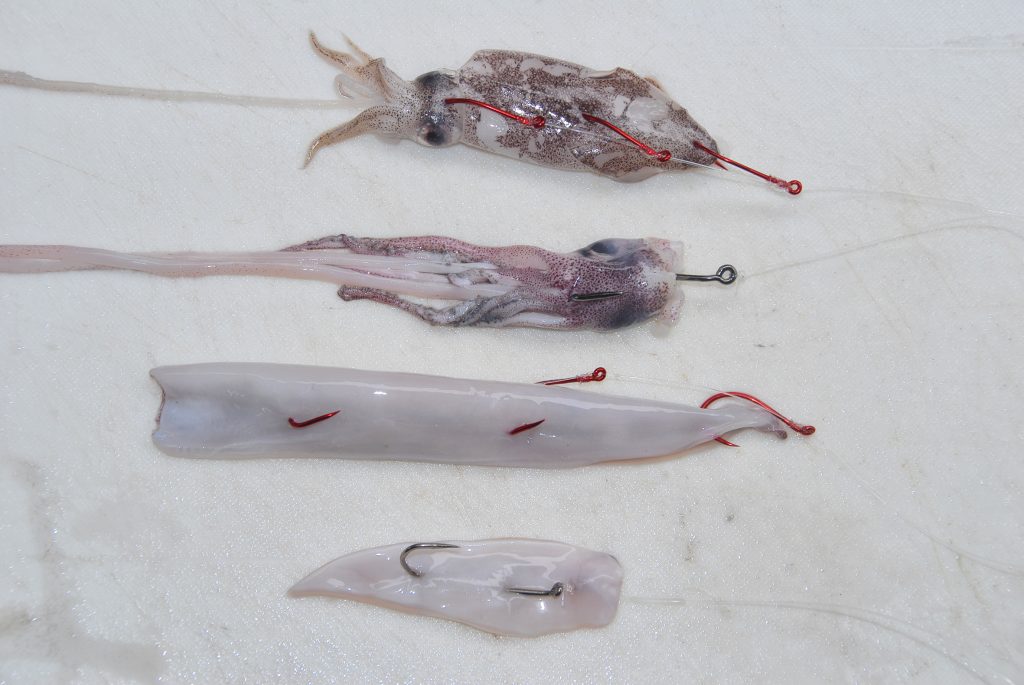
8. GUT
A lesser used bait is gut. Mullet gut and fowl gut are available from most bait outlets, however, gut from most fish species can be used. Despite being a relatively messy bait to deal with, gut can be quite effective. It has good movement in the water. When the pickers are attacking it, plenty of natural berley and flavour is emitted.
An octopus or baitholder pattern hook can be used to present gut baits, and larger gut baits may even allow you to use a two hook snelled rig.
Gut from your catches on one trip can be used for the next trip. Fowl gut is usually from grain fed battery cage chickens and as a result the intestines are filled with a fine grain concoction, which makes excellent berley once the pickers start munching. The berley and the commotion from these smaller fish will attract any larger knobby, bream, sweetlip or other species lurking throughout the area. Although probably not the ideal bait for mulloway, species such as snapper, large bream and cod love fresh gut bait.
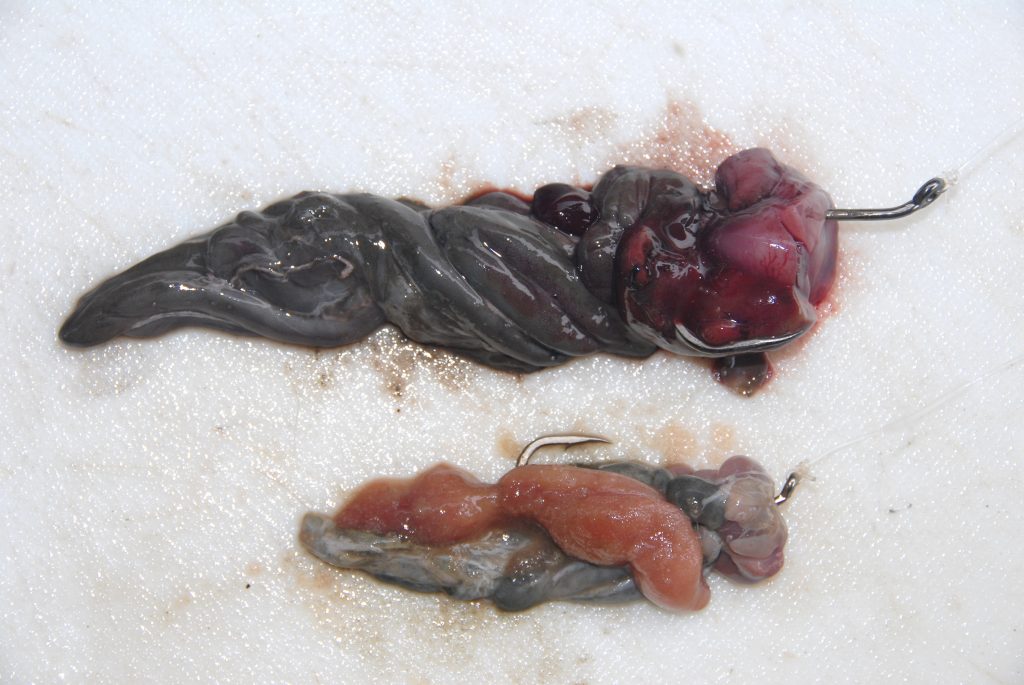
9. CHICKEN FILLET
An effective bait that often isn’t even considered is chicken fillet. This clean white, relatively tough flesh is decent bait for many demersal species. Bream in particular love chicken fillet. Small strips of chicken fillet can be pinned on a single baitholder style hook to target these, as well as sweetlip and many other species. Larger strips of chicken fillet can be presented on a snelled hook rig (or ganged hooks if you prefer) for targeting snapper and others.
Many anglers like to soak their chicken fillet in tuna oil, garlic or aniseed, especially when bream are the target species. Obviously chicken fillet is easily sourced from any supermarket and can be a good option for that last minute trip when the bait shops have already closed.
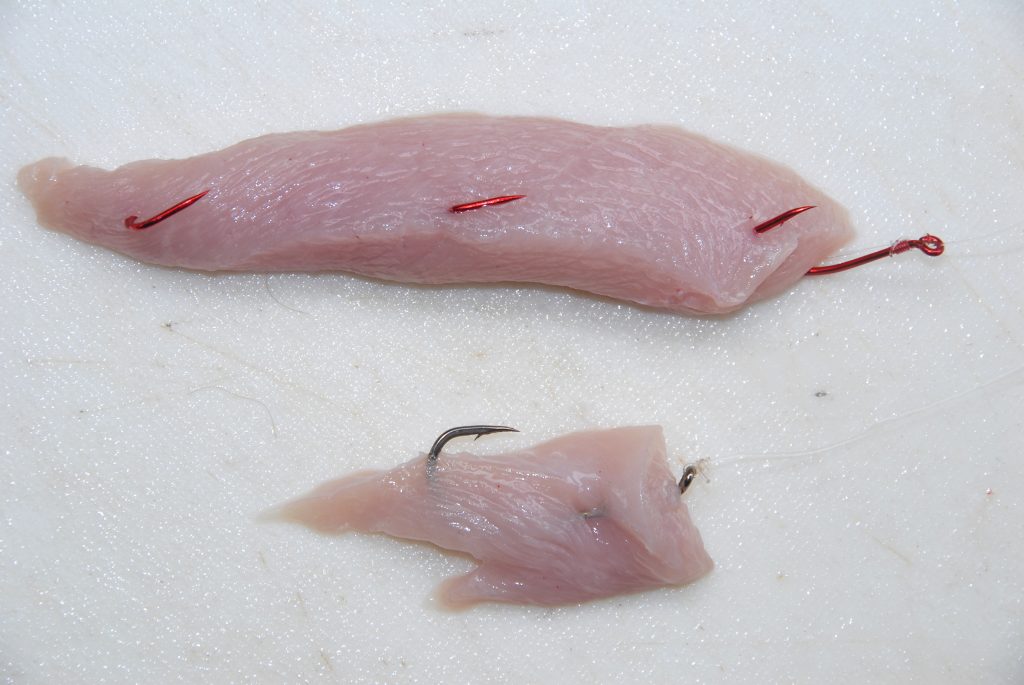
10. CRABS
A bait that is underestimated and underused is crabs. Most species of crabs make ideal baits for a host of species including snapper, tuskfish, big bream and cod. You will need to be aware of the relevant size limits that apply to many species of crabs and which species you can take. Even though you are using them for bait, they must still exceed minimum size limits for the species and you must be within your bag limit.
Sand and blue swimmer crabs can be split or broken into smaller pieces when being used for most larger species. However, anglers that target the large tuskfish will often use a whole blue swimmer, or three spot crabs. Most of the tuskies they target are in excess of 8kg and pull like a freight train, however, smaller tuskfish will also break up and engulf such a bait. Broken pieces of crab can be pinned on a single large hook that is generally pierced through a leg hole and then back through the softer, upper side of the shell (which has already had the carapace removed).
Smaller whole dead crabs, such as the purple and black rock crabs, ghost crabs and others, can be hooked in a similar manner by removing one leg, pinning the hook through and then pushing the point back out so it is proud of the carapace.
For presenting a whole live crab there are a couple of different options. A hook can be glued to the top of the shell using hot melt glue or some other fast setting glue or silicone. This is usually done so that the point is placed upright in the middle of the shell. Crabs can be caught the day before, kept alive with the hooks already glued in place and then attached to the leader and deployed at will.
Another method for large dead or live crabs is to use a two hook snelled rig and attach the hooks to each side of the crab using rubber bands onto the carapace or around the legs. Several smaller rock crabs or soldier crabs can be pinned consecutively onto a baitholder pattern hook.
Crabs make ideal baits for a host of species, it just often takes a bit of effort beforehand to gather them for a session on the water. If you want to target tuskfish, then they are the number one bait for this species. Cod also favour crabs over most other food sources and I have also had success on cobia when using whole sand crabs. Small crabs are great bait for large, peg-toothed bream and a host of other species to boot.
Hopefully this article will enlighten you to some new bait options and different ways to rig them. Getting away from just using frozen squid, prawns and pillies, which are the most common baits, will likely increase your catch rate. These trusty baits still catch you a lot of decent fish, but there is a host of other frozen and fresh offerings available.
You’ll need quality rigging to increase your chances when using any bait. Try a few of these out next time you go out to get amongst them.
